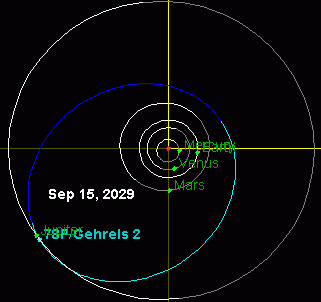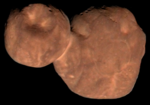|
78P/Gehrels
78P/Gehrels, also known as Gehrels 2, is a Jupiter-family periodic comet in the Solar System with a current orbital period of 7.22 years. It was discovered by Tom Gehrels at the Lunar and Planetary Laboratory, Arizona, USA on photographic plates exposed between 29 September and 5 October 1973 at the Palomar Observatory. It had a brightness of apparent magnitude of 15. Brian G. Marsden computed the parabolic and elliptical orbits which suggested an orbital period of 8.76 years, later revising the data to give a perihelion date of 30 November 1963 and orbital period of 7.93 years.[6] The comet's predicted next appearance in 1981 was observed by W. and A. Cochran at the McDonald Observatory, Texas on 8 June 1981. It was observed again in 1989 and in 1997, when favourable conditions meant that brightness increased to magnitude 12.[6] It has subsequently been observed in 2004 when it reached magnitude 10, 2012, and 2018.[1] Outward migrationComet 78P/Gehrels' aphelion (furthest distance from the Sun) of 5.4AU[3] is in the zone of control of the gas giant Jupiter and the orbit of the comet is frequently perturbed by Jupiter.[7] On September 15, 2029, the comet will pass within 0.018 AU (2.7 million kilometers) of Jupiter[7] and be strongly perturbed. By the year 2200, the comet will have a centaur-like orbit with a perihelion (closest distance to the Sun) near Jupiter.[8] This outward migration from a perihelion of 2AU to a perihelion of ~5AU could cause the comet to go dormant.
 See alsoReferences
External links
|
||||||||||||||||||||||||||||||||||||||||||||||||





